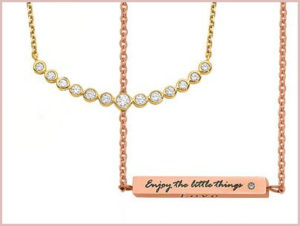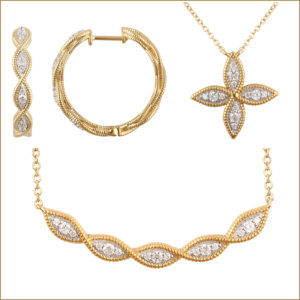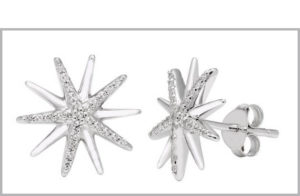Key Gifters and Self-Giving
When it comes to fine jewelry, it’s imperative retailers and manufacturers understand what women want and how to reach them.
The keyword in gifting is “self” and the key gifters are women, when it comes to fine jewelry, so it’s imperative for retailers and manufacturers to understand what women want and how to reach them.
Research by MVI Marketing finds that 51 percent of female consumers buy jewelry for themselves, 14 percent buy for their partner/spouse, and 17 percent make purchases together with their partner/spouse. That equates to women buying and influencing 81 percent of all jewelry sales.
![]() There have been significant shifts in jewelry gifting, based largely on changing attitudes among consumers, reports retail market consultant Kate Peterson of Performance Concepts, Montgomery Village, Maryland. “Women across the country are adding jewelry to the list of self-purchase fashion luxuries, where a stunning pair of diamond earrings ranks right up there with a $1,200 handbag or pair of boots.”
There have been significant shifts in jewelry gifting, based largely on changing attitudes among consumers, reports retail market consultant Kate Peterson of Performance Concepts, Montgomery Village, Maryland. “Women across the country are adding jewelry to the list of self-purchase fashion luxuries, where a stunning pair of diamond earrings ranks right up there with a $1,200 handbag or pair of boots.”
In research for The Plumb Club, the Italian trends forecasting firm, The Futurist finds greater movement towards self-gifting, especially among younger consumers. Not only do they have the disposable income, the shifting demographics see younger people starting a family much later in life, resulting in a more self-rewarding attitude. Purchasing gifts for oneself has become a way to express one’s individuality.
De Beers’ research finds the self-gifting trend to be one of the clearest opportunities for growth in the jewelry industry. It advocates jewelers place as much emphasis on self-gifting as they do on bridal and other relationship gifting occasions. The Diamond Producers Association, for which De Beers is one of the seven major producers in the group, has been promoting its “For Me, From Me” campaign celebrating self-gifting and the emotional connection women have to diamond jewelry. That marketing muscle is pushing the self-gifting message.
Message-Bearing
In its research, The Futurist found that a majority of consumers surveyed would consider wearing and buying for themselves and for others as gifts, jewelry that makes a statement and tells a story about the individual.
The most compelling motifs for self-gifting and gifting to others emerged as the “guiding stars” — the Polar Star and the Sun, universally recognized symbols for guidance, hope and inspiration. The research inspired The Plumb Club’s Radiant Universe Collection, featuring member designs interpreting this theme.
Represented in the jewelry were literal, abstract and elongated star and sun designs; asymmetrical rays, half-stars  and fan shapes; gems in constellation patterns; and combinations of celestial beings. Other popular design notes include diamond and gem dusted/encrusted surfaces, organic and irregular pavé and clustered settings; and star shapes carved in metal and set with diamonds.
and fan shapes; gems in constellation patterns; and combinations of celestial beings. Other popular design notes include diamond and gem dusted/encrusted surfaces, organic and irregular pavé and clustered settings; and star shapes carved in metal and set with diamonds.
Personalized products that can be engraved with initials, signatures, and messages, even fingerprints remain center stage, says Cora Lee Colaizzi, marketing director and senior merchandiser for Quality Gold. A recent trends report by the Fairfield, Ohio based manufacturer identifies charms as a key style that layers on meaning to any jewelry wardrobe.
The Futurist identifies charms and lockets popular styles for storytelling and personal reflection. The report also underscores the affinity consumers have with color, and the variety of gem types in fashion. Multi-color waves, achieved within a singular design or by stacking colorful styles together, are prevalent.
Birthstones remain the go-to design elements to personalize any piece, cites Theresa Namie, merchandise manager for the Minneapolis, Minnesota-based manufacturer, Ostbye. She advises retailers stock updated birthstones, three-stone, two-stone, and journey designs that make great family jewelry styles.
 Talking to Women
Talking to Women
The differences between men and women are profound when it comes to marketing and selling. “Men are interested in visuals of an item, and anything performance or status-related about the item,” explains marketing consultant Andrea Hill of the Hill Management Group in the recent Plumb Club webinar with Holland. “But women are generally more interested in ideas and relationships associated with the item. Boys watch objects, girls watch faces.”
For most women, jewelry is about life, love, fashion, or personal accomplishment. It’s critical to show the female shopper how the jewelry fits with her life, says Hill. Focus on the context not the thing. It’s about the ideas around the thing and its relationship to other things. Women need objective and subjective information. They want emotional and social cues, as well as design and functional details.
Moreover, women are organic shoppers, creative and indirect, says Hill. It’s not about service, as much as collaboration. Events are a great way to engage with customers and get them into your stores, advocates Namie. “Have a wish ‘list night’ for the ladies. Then hold a ‘reveal’ night for the men. Plan it around your clientele. Have items in boxes ready to go. Gift sets already boxed work great for helping customers to choose.”
Shopping for women is about the hunt, says Hill, advising retailers to merchandise for experience, not categories. Create interest in, confidence about, and desire for products with live demonstrations, and display layouts that tell stories. Says Peterson; “Layout your merchandise by designer, gemstone, color, season, and occasion — anything that makes sense to customers and allows them to see what everything within view has in common. That makes things easier for gift buyers once the sales professional can help them identify the characteristics most important to the recipient or gift message.”
Additionally, social media is a critical part of the gift-giving experience, as a platform for ideas, validation for  purchases, and to share the story behind the gift. Research from She-conomy finds Facebook and Instagram critical components to reaching the female audience. Over 60 percent say Facebook is the most important and useful social media channel to research retail, and the place women go to before visiting a store or website.
purchases, and to share the story behind the gift. Research from She-conomy finds Facebook and Instagram critical components to reaching the female audience. Over 60 percent say Facebook is the most important and useful social media channel to research retail, and the place women go to before visiting a store or website.
Women resonate the most with communication mediums that allow them to have conversations, and that deepens engagement over time, underscores Hill. “Everyone loves a pretty picture, but women respond even better to dialog. It’s why getting all those comments on Pinterest pins and Instagram posts works for women. Offer marketing that creates an ongoing connection.”










